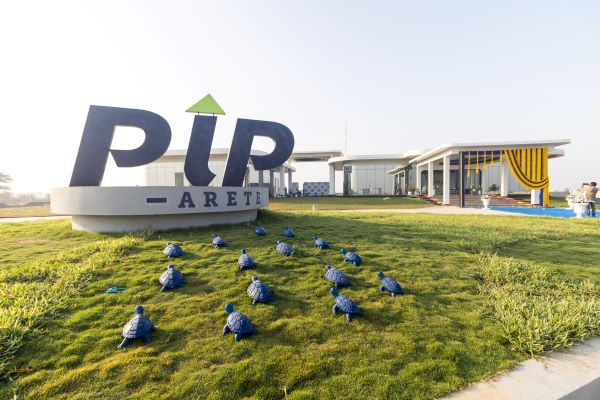Through promoting innovation and minimizing operational friction, the industrial clusters place Indian firms in a position to react more quickly to market needs and grow sustainably

India's aspiration to become a global manufacturing center has picked up strong pace over the past few years, fueled by policy planning strategies, surging world demand, and changing industrial landscapes. Central to this change is a pivotal but relatively lesser-known segment— chemical industrial parks. These specially designed complexes are not only drivers of chemical production; they are catalysts for change, allowing India to scale the heights of global manufacturing.
A Backbone for Industrial Growth
The chemical sector is the foundation of many high-growth industries such as pharmaceuticals, textiles, agrochemicals, construction, and automotive. Being one of the most diversified sectors, it accounts for more than 7 per cent of India's GDP (Source: Department of Chemicals and Petrochemicals, Ministry of Chemicals & Fertilizers) and is expected to grow to US$ 300 billion (Source: Invest India).
Chemical industrial parks function as coherent and coordinated ensembles that conglomerate chemical factories, ancillary establishments, research and development establishments, and supporting suppliers in an organised and coordinated setup. Shared resources of infrastructure, collective effluent treatment plants, well-entrenched logistics, and waste processing networks, and shared service centers like banking and commerce make the economic system cost-reduced and process-intensified.
For a high-compliance-based industry that expects to run processes under great constraint from environmentally benign norms as well as from protection-of-human-life-saving provisions, such location centers have definite benefits. India's cluster-based industrial development strategy has fructified in clusters such as Dahej PCPIR in Gujarat, Paradip in Odisha, and Cuddalore in Tamil Nadu—each with intense backward and forward linkages (Source: PCPIR Policy Report, Ministry of Chemicals & Fertilizers).
Infrastructure That Drives Sustainability
This vision was reiterated at the recent conclave organized by Arete Group to commemorate the launch of Phase 2 of Payal Industrial Park (PIP) at Dahej, Gujarat. The conclave was attended by more than 250 industry captains, policymakers, and sustainability champions, highlighting the pivotal role that composite infrastructure such as CETPs (Common Effluent Treatment Plants) has to play in supporting growth with a conscience.
At the core of this is the commissioning of PIP's cutting-edge 2.5 MLD Common Effluent Treatment Plant (CETP), part of a total permitted capacity of 50 MLD. Designed for high-COD effluent (5,000 ppm COD and 1,800 ppm BOD), the CETP enables industrial units to reduce their investment in separate treatment plants.
With plug-and-play capabilities, the facility enables firms to acquire faster environmental clearances, reduce upfront capex, and maintain compliance through a Ministry of Environment, Forest and Climate Change (MoEFCC) approved deep-sea discharge mechanism. The CETP is more than a treatment plant; it reflects PIP's dedication to circular economy and optimization of resources. With other future plans such as a solar power plant, hydrogen production, and intelligent utility corridors, the park is setting the stage for a net-zero industrial ecosystem.
A Platform for Competitiveness and Innovation
Apart from compliance, such chemical parks are also crucibles of collaboration. Their design allows for synergies between units, allowing sharing of resources, optimal inventory, and reduced logistics costs—factors of prime importance in enhancing global competitiveness. Through promoting innovation and minimizing operational friction, such industrial clusters place Indian firms in a position to react more quickly to market needs and grow sustainably.
Augmenting Export Potential
India is already one of Asia's leading three chemical manufacturers (Source: IBEF) and exports to over 175 nations (Source: Ministry of Commerce & Industry, EXIM Data). Chemical industrial parks leverage this potential by aggregating production capacities, rationalizing supply chains, and referencing quality to global standards. With increasing focus on specialty and green chemicals, these parks are assisting India in grabbing high-value export markets.
Attracting Investments through Policy Support
The Indian government has played an important role in driving the sector forward with initiatives such as Production Linked Incentives (PLI), Make in India, and PCPIR policy. These initiatives have greatly enhanced the ease of doing business and enabled more than US$ 20 billion in FDI from April 2000 to March 2023 (Source: DPIIT). A lot of this investment has been routed through chemical parks that provide scale, predictability, and regulatory certainty. Centralized environmental control, as provided by CETPs, also adds to investor confidence by making compliance easier and ensuring sustainability in operations.
The Road Ahead
As international industries look to diversify out of China-led supply chain, India has a singular window of opportunity to emerge as a trusted and resilient manufacturing partner. The modernization and strategic development of chemical industrial parks will unlock this potential. Through green technology investments, digital infrastructure investments, and skill upgradation, these parks are upgrading to future-ready manufacturing parks in line with Industry 4.0 and international ESG standards.
(Source: NITI Aayog & FICCI Reports)
Subscribe to our newsletter & stay updated.